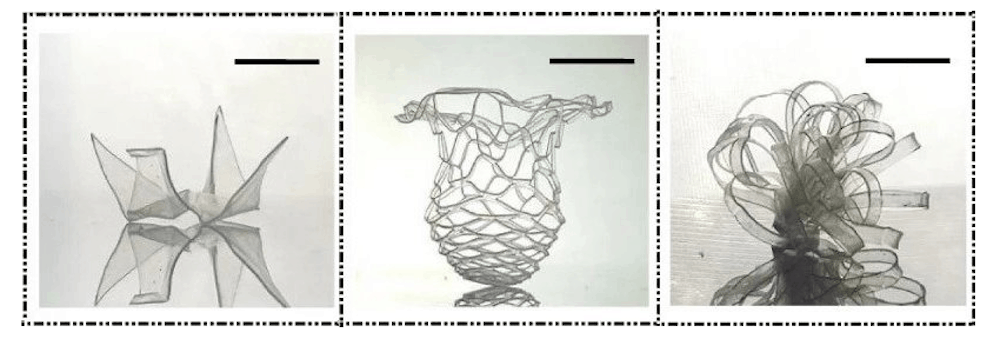
[Image above] Examples of a glass crane, vase, and flower created via origami. Credit: Xu et al., Nature Communications (CC BY 4.0)
From bridges to guitars to nail art, glass has been used to create some pretty unique things. Yet shaping glass into complex geometries remains somewhat limited compared to metal and polymers.
“Conventional glass shaping operates under harsh conditions such as high temperature or chemical etching. Sol-gel chemistry allows defining glass shapes under milder conditions, but the geometric complexity is inherently limited by the molding technique involved,” researchers explain in a recent open-access paper.
In the past few years, research on using silica-polymer composites as the precursor for glassmaking has offered opportunities to create glass with more complex geometries. These composites can be molded at low temperatures through subtractive or additive manufacturing processes, and then heat treated to remove the polymer, leaving behind the complex-shaped glass.
While 3D printing of precursor composites has resulted in some successes, the approach still runs into limitations, including resolution and surface roughness (in the case of stereolithography) and compromised print size and productivity (in the case of two-photon polymerization).
Origami is another shaping technique that has experienced new life in recent years in many engineering areas, including soft robotics, wearable electronics, aerospace structures, and medical devices.
Origami involves converting a planar sheet into 3D geometries. Though at first it may appear a contradictory choice for brittle glass, “with the delicate molecular design of the precursor composite, it is possible to introduce mechanisms that make it deform in such a way that permits origami-shaping of transparent glass,” the researchers of the open-access paper write.
The researchers come from Zhejiang University in China, and they investigated the possibility of shaping glass via origami techniques in their recent study.
They start by noting that for the composite to be foldable like paper, it must have plasticity, or the ability to change shape permanently when subjected to stress. Both physical and chemical mechanisms can induce plasticity, and the researchers designed their composite to exhibit both.
“The physical plasticity is more convenient since it does not require heating during the folding. By comparison, chemical plasticity is more favored when high shape retention is needed,” they write.

They fabricated the composite sheet by curing a silica nanoparticle-filled liquid precursor. Then, after cutting the sheet into the desired shape, they folded it using manual techniques similar to actual paper origami. “Further pyrolysis and sintering remove the polymer binder and convert the 3D object into glass,” they write.
The researchers succeeded in creating several impressively complex shapes via origami techniques, including a crane, vase, and flower. In particular, the crane relied on physical plasticity whereas the vase and flower relied on chemical plasticity.
“These origami glasses are challenging to produce with 3D printing as it would require extensive support structures that are cumbersome to remove. The surface smoothness is also difficult to achieve with regular 3D printing,” they write.

The researchers note that while they manually folded the composite sheets in this study, the process could be automated and thus is suitable for large-scale manufacturing. “More importantly, our process does not use molds, thus the geometric complexity is not bound by traditional molding techniques,” they write.
The open-access paper, published in Nature Communications, is “Transparent origami glass” (DOI: 10.1038/s41467-021-24559-x).
